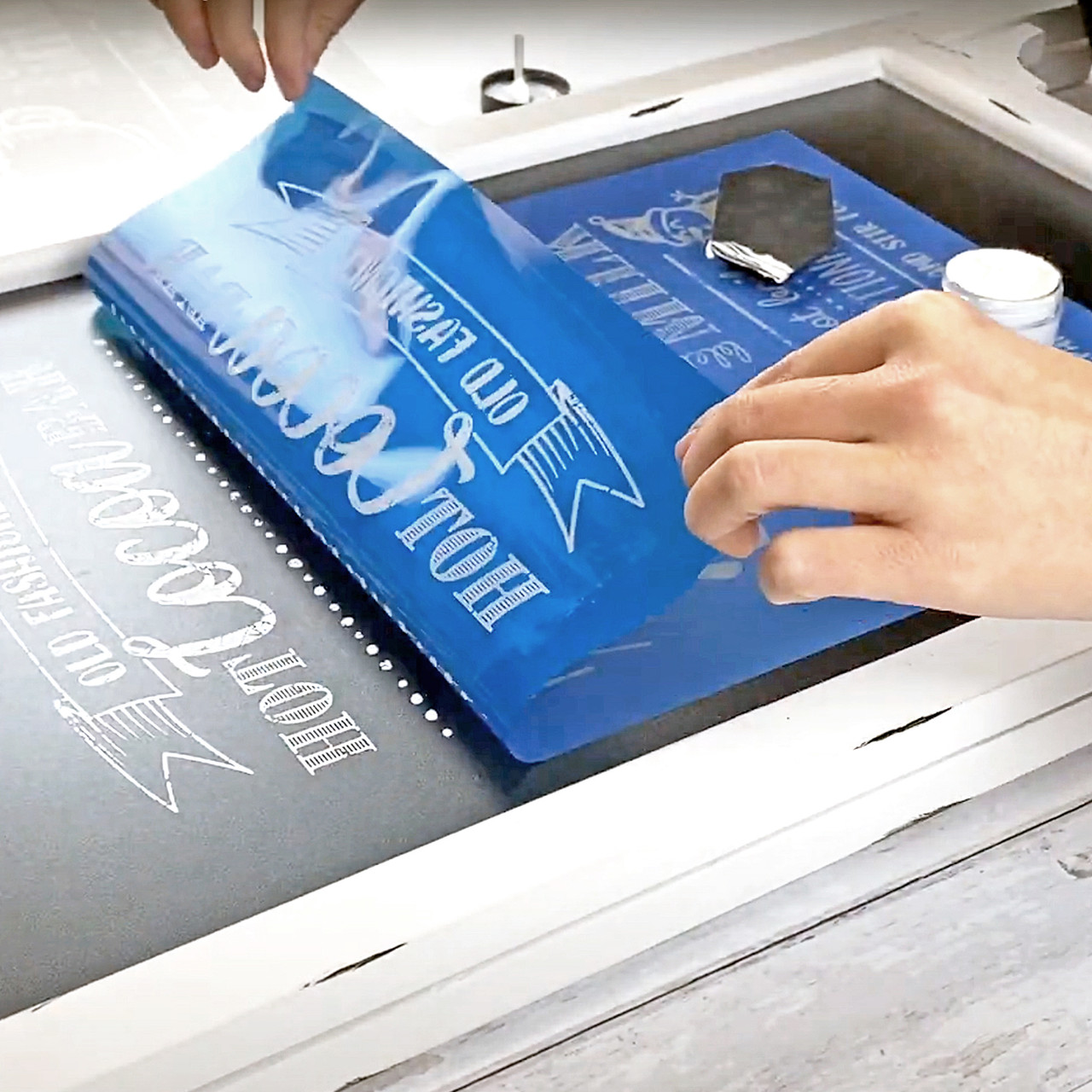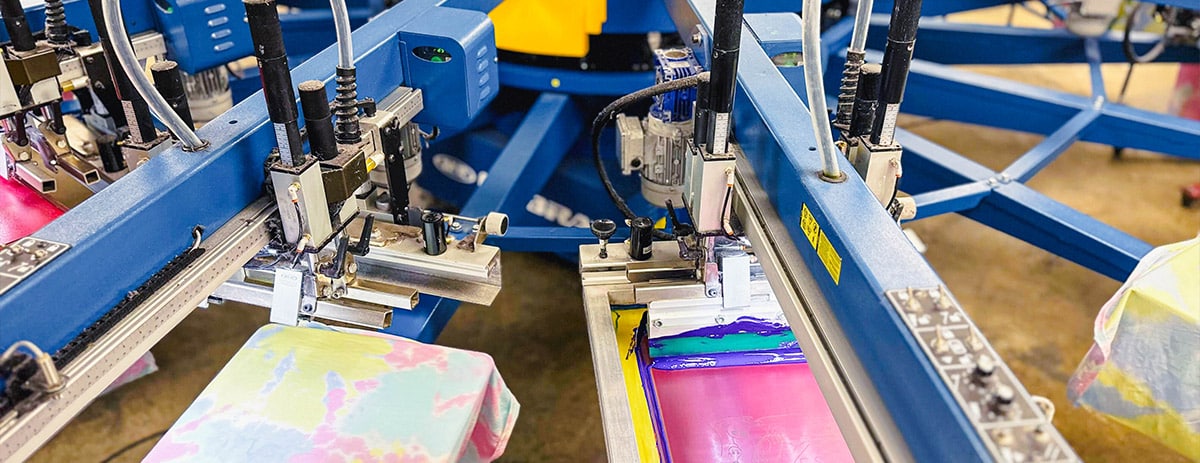Screen Printing Uncovered: Everything You Required to Know About Tee Shirt and Garment Printing Strategies
If you've ever before questioned exactly how those dynamic styles wind up on your preferred tee shirts, you remain in the right place. Display printing is a remarkable method that integrates art with method, providing unlimited possibilities for creative thinking. Recognizing the principles, from devices to ink selections, can greatly impact your outcomes. All set to discover the necessary aspects that make screen printing an art kind? Let's uncover the information that can raise your jobs.
The Fundamentals of Display Printing: Exactly How It Works
When you plunge into display printing, you'll find it's both an art and a science. At its core, display printing includes producing a stencil, or screen, that allows ink to go through just in particular locations (screen printing kit). You begin by choosing your layout and preparing your screen with a light-sensitive solution. Once you reveal this solution to light, it hardens, leaving your layout as an adverse area.
Setting the display over the fabric, after that make use of a squeegee to push ink through the display onto the garment. Each step is vital, and understanding them will elevate your display printing abilities, transforming easy garments right into special, expressive items.
Sorts Of Screen Printing Strategies
As soon as you comprehend the essentials of screen printing, it's time to explore the numerous methods that can elevate your designs. One popular technique is standard display printing, where ink is pressed via a stenciled display. This strategy is terrific for vibrant, vivid shades. There's water-based ink printing, which offers a softer feel and is green, yet it calls for a various strategy to healing.
Another alternative is plastisol printing, known for its toughness and dazzling shades, making it a favorite for numerous brands. Experiment with halftone printing to produce gradient effects and intricate layouts.
Essential Tools for Screen Printing
To attain spectacular results in display printing, having the best equipment is essential. You'll need a strong screen printing frame, which holds the mesh that transfers your design onto the garment. Next, spend in high-quality mops; these are necessary for using ink uniformly across the screen.
Selecting the Right Inks and Materials
When selecting inks and materials for display printing, you require to consider the kind of ink that functions finest for your job. Think of material compatibility to guarantee your designs look last and excellent lengthy. Discover green ink choices to make your printing procedure much more lasting.
Kinds Of Screen Inks
Choosing the best display ink is essential for achieving lively, durable prints that meet your task's requirements. There are numerous kinds of display inks to analyze. Specialized inks, such as metal or glow-in-the-dark, can add unique impacts to your styles.

Fabric Compatibility Factors To Consider
Recognizing textile compatibility is vital for achieving top quality display prints, especially since various products react distinctly to various inks. When selecting inks, take into consideration the textile type-- cotton, polyester, or blends. For cotton, water-based inks work well, offering gentleness and breathability. Polyester, on the various other hand, typically requires plastisol inks for far better bond and lively colors. You could require to use a combination of both types if you're printing on blends. Always examine your inks on example material to ensure they adhere effectively and keep color integrity. Additionally, remember that textile weight and appearance can influence the final result, so selecting the appropriate ink and product combo is essential for your job's success.
Eco-Friendly Ink Options
Eco-friendly inks are becoming a popular selection for screen printers who desire to minimize their environmental impact while keeping high quality. When picking inks, consider water-based inks, which are much less hazardous and less complicated to clean up contrasted to typical solvents.
In addition, search for inks made from renewable energies, such as soy or vegetable-based alternatives. By picking the best inks and products, you'll not just produce spectacular styles yet also contribute to a more lasting printing procedure. Make the button, and your prints will certainly show your commitment to the environment!
Preparing Your Layout for Display Printing

File Style Needs
To guarantee your layout looks lively and sharp on material, you'll require to pay close focus to submit style needs for display printing. Make certain your layout has a transparent background to avoid undesirable white sides on your prints. Maintain color settings in mind; CMYK is basic for screen printing, so convert your RGB designs appropriately.
Shade Separation Strategies
Shade splitting up is an important action in preparing your style for display printing, and mastering it can considerably improve your print quality. You'll need to damage your design right into individual colors, as each color calls for a different screen throughout printing. Start by recognizing all the shades in your design and create layers for each one. You can use software application like Adobe Photoshop or Illustrator to separate and separate shades successfully. Be specific to conserve each layer as a separate data, generally in a style like TIFF or PSD. This precision not just ensures accurate shade depiction but additionally streamlines the printing procedure. By paying interest to color splitting up, you'll achieve dynamic and professional cause your screen-printed garments.
Resolution and Dimension
Attaining the very best cause display printing starts with guaranteeing your layout has the right resolution and dimension. Preferably, your artwork needs to go to the very least 300 DPI (dots per inch) for sharp, clear prints. Your final product may look unprofessional and pixelated. if you make use of lower resolution.
When it concerns size, think about the dimensions of your print location. Design your artwork to match the last print dimension, ideally creating it in the actual dimensions you'll be printing. This means, you'll prevent any kind of unexpected scaling concerns.
Constantly inspect your layout in both vector and raster formats. Vector graphics can be scaled without losing top quality, making them suitable for screen printing. Preparing correctly will guarantee your style looks impressive on every garment!
Step-by-Step Screen Printing Refine
Screen printing is a dynamic procedure that allows you to produce dynamic layouts on various surface areas. To begin, you'll require a screen, emulsion, and your chosen ink. Prepare your screen by cleansing it extensively. Next off, apply the solution evenly and allow it dry in a dark area. When dry, expose your screen to light with your style positioned on it, which will certainly solidify the emulsion where the light hits, producing a stencil - screen printing kit.
After rinsing the unexposed emulsion, your display is all set. Set it up on your printing surface area and align your garment below it. Pour ink onto the screen and use a squeegee to push the ink through the pattern onto the fabric. Raise the display carefully and allow the print dry. Cure the ink utilizing heat to assure longevity. That's it! You have actually efficiently screen printed your design.
Tips for Successful Display Printing Projects
While you're diving into your screen printing projects, bear in mind that preparation is essential to success. Beginning by gathering all your products-- inks, garments, mops, and displays. A tidy work area aids protect against undesirable mistakes, so clean prior to you start.
Next, validate your art work is high-resolution and effectively sized for your garment. Check your screen for appropriate exposure and tidy it extensively to stay clear of spots. When mixing your inks, comply with the manufacturer's guidelines to achieve the best consistency.
Throughout printing, use also stress with your squeegee for consistent Learn More results. Do not hurry; take your time to confirm each print meets your criteria. After printing, let your garments dry entirely before dealing with or packaging them.
Finally, always maintain a sample of your help future referral. By doing this, you can analyze your progress and improve your techniques gradually. Pleased printing!

Often Asked Questions
For how long Does It Take to Set up a Screen Printing Task?
Establishing a screen printing job generally takes around thirty minutes to an hour. You'll prepare the displays, mix inks, and change the press. The moment varies based upon intricacy and experience, so remain organized!
Can I Print on Various Textile Keys In Using the Same Strategy?
Yes, you can publish on different fabric types using the same technique, yet you'll require to change your inks and setups. Some fabrics take in find more information ink differently, so experimenting guarantees the most effective outcomes for each product.
What Are Typical Blunders to Stay Clear Of in Screen Printing?
When screen printing, prevent common mistakes like making use of the wrong ink, overlooking proper direct exposure times, or missing pre-press checks. Constantly test your setup and preserve clean displays to guarantee top quality results each time.
How Can I Correctly Tidy and Maintain My Display Printing Equipment?
To effectively tidy and keep your screen printing equipment, you ought to on a regular basis wash screens with proper solvents, examine squeegees for wear, and guarantee all tools are stored completely dry and dust-free. Uniformity avoids pricey fixings and boosts performance.
Is Display Printing Eco-friendly Contrasted to Various Other Approaches?
Display printing can be a lot more environmentally friendly than various other techniques, particularly if you make use of eco-conscious products and water-based inks. By selecting sustainable materials and methods, you lower waste and decrease your effect on the earth.
Display Printing Uncovered: Whatever You Required to Know About Tee Shirt and Garment Printing Methods
At its core, display printing entails creating a stencil, or display, that permits ink to pass via just in specific areas. Setting the display over the material, after that make use of a squeegee to press ink read review with the display onto the garment. One preferred method is conventional screen printing, where ink is pushed through a stenciled screen.When selecting inks and materials for display printing, you need to take into account the kind of ink that functions ideal for your task.